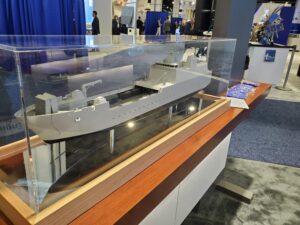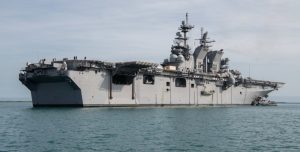NATIONAL HARBOR, Md. – The leaders of the House Armed Services Committee (HASC) Seapower subcommittee support continuing the Flight II San Antonio
-class (LPD) amphibious transport dock ships, as opposed to Navy plans in the latest budget request to end it.
During a panel here at the Navy League’s annual Sea Air Space expo on Monday, Rep. Joe Courtney (D-Conn.), chairman of the HASC Seapower subcommittee, said he is in favor of the Marine Corps’ request for advance procurement funds for LPD-33 in FY ‘23.
Last week, the Marine Corps’ unfunded priority list submitted to Congress with the FY ‘23 budget request put $250 million in advance procurement for LPD-33 as the top item (Defense Daily, April 1).
“I think [Commandant of the Marine Corps Gen. David Berger] and [Deputy Commandant for Combat Development and Integration Lt. Gen. Karsten Heckl] make a really powerful argument to all of us, and I think that’s one of those items that’s going to change,” Courtney said
“You need to do advanced procurement on LPD-33 now. Get that done,” Rep. Rob Wittman (R-Va.), ranking member of the subcommittee, agreed.
Last week, Navy Deputy Assistant Secretary for Budget Rear Adm. John Gumbleton told reporters the service was planning to end the LPD-17 Flight II class with LPD-32, although the Marine Corps evidently disagrees with that plan given its separate unfunded priorities list.
Courtney said he thinks the Marine Corps has made a “convincing case” that LPDs have a mission and expressed concern that cutting the program off could be bad for the country. As co-chair of the shipbuilding caucus, he said the idea of cutting off a ship class like LPDs and the effect it would have on the shipyard, workforce, and supply chain generally “gives me hives.”
He continued that shutting off production on LPDs is “poison in terms of the damage you can do to suddenly knock out a program.”
Courtney said while he does not think the Navy should build ships as a jobs program for local economies, if the service can make a convincing case of its value and mission, “clearly we have to be very mindful of a cutoff or a cliff. And we’ve found plenty of cases in the past where we’ve taken a ship that we built for one purpose and we adapted it to another.”
He added it seems like the LPD fills out a lot of roles beyond its traditional amphibious missions.
The San Antonio-class Flight II LPDs are built by HII’s Ingalls Shipbuilding [HII] with its shipyard in Pascagoula, Miss. That shipyard builds Arleigh Burke-class destroyers, LPDs, America-class amphibious assault ships (LHA-6), and Legend-class National Security Cutters for the U.S. Coast Guard.
HII is the new corporate name for Huntington Ingalls Industries.
When asked if the Navy might try replacing LPDs with the new Light Amphibious Warship (LAW), Wittman said he thinks “we should build them both” and argued LAW “is different from a large lift vessel. It is not an LPD. These are intra-theater connectors and what the Marines are going to need to move around.”

The Navy’s FY ‘23 budget request pushed back the first LAW procurement to FY ‘25, with it then being delivered around FY ‘27. Last week, Gumbleton told reporters the Marine Corps and Defense Department are still tightening requirements on LAW (Defense Daily, March 30).
The Navy and Marine Corps plan to procure 24 to 35 LAWs, which will be used to transport 75 Marines and 8,000 to 10,000 square feet of cargo up to 3,000 to 4,000 miles as the primary supporting ship for the Marine Littoral Regiment (MLR). The MLR is expected to include 1,800 to 2,000 Marines and sailors.
“Those are the connectors that we need for the future. We have things like the Ship-to-Shore Connectors now, [Expeditionary Fighting Vehicles]. That’s not what these things are. These things do that intermediate element to where the large amphibious ships can now with a lot more effectiveness. And then when you deploy, you can now distribute your risk across the theater. You can create some uncertainty for your adversary. You can’t do that with just one or the other. You have to be able to use both,” Wittman said.
Wittman said the budget request delay in getting LAWs operational “ is going to create a challenge for the Marine Corps in order to be able to operate in the distributed way that they envision in the Indo-Pacific. And if they are going to have the ability to impose a level of uncertainty, a level of risk on the Chinese, they have to be able to operate differently.”
He argued these Marine Corps vessels “have to be able to operate in a distributed manner. Our amphib ships, ships with well decks, are going to be incredibly important there, but you also have to have those intra-theater connectors. And it’s more than just an LCAC or a Ship-to-Shore Connector…You have to be able to move things around, Marines and equipment.”
Wittman said this ability to move these kinds of numbers and capabilities around increases the uncertainty for the Chinese military, “because they’re not going to be quite sure what’s going with that Marine Corps unit, what they have in their hands, and how they are going to impose risk and how do you move that risk around.”
He argued that if the Chinese military is unsure what assets are on the LAWs, that changes the risk calculus for them, increasing China’s uncertainty in a conflict, which is part of a successful Indo-Pacific strategy for the U.S.
When asked about LAW expenses and survivability, Wittman said the ship should not focus on expensive survivability requirements by design.

“It’s more of a connector, so your connectors are never designed to be survivable. It’s the same thing that’s happened with our logistics ships. If you keep adding requirements there, you drive the cost up, then you end up with a billion dollar logistics ship. That’s not what we need. The LAWs are the same way. The LAWs are not meant to be a warship, they’re meant to be, as they say, a connector. If they’re a connector, let’s make them a connector.”
Relatedly, both Courtney and Wittman agreed the Navy’s FY ‘23 request listing LHA-9 as one of nine requested ships is an incorrect double count.
Congress originally approved construction of LHA-9 in the final FY ‘20 defense budget. However, in the FY ‘21 budget request, the Navy listed it as a new ship projected for procurement in FY ‘23, increasing the overall projected ship count. As a result, the FY ‘21 defense authorization act contained a provision that this kind of double counting shall not happen again.
However, members of Congress are not pleased with what they call a repeated double count.
Last week, Sen. James Inhofe (R-Okla.) ranking member of the Senate Armed Services Committee, said on Twitter that the Navy double counting LHA-9 is a violation of the law.